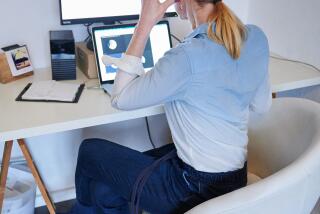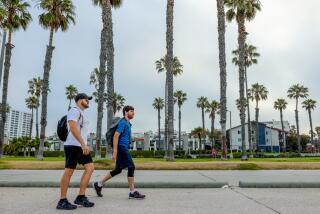When It Comes to Exercise, Little Things Mean a Lot
Swiping your credit card at the pump burns only five fewer calories than walking into the gas station to pay. Opening a bag of pre-sliced veggies expends just 12 fewer calories than washing, slicing and chopping fresh ones. Riding the elevator uses 15 fewer calories than climbing three flights of stairs.
But add up the energy it takes to do these and 17 other common tasks in a sedentary manner--and compare the result with the calories burned performing the same tasks actively--and the difference is the energy equivalent of 2 1/2 pounds of body fat over a month and 30 pounds over a year, says a Dallas epidemiologist who is a pioneer in the growing movement to “jump-start” our increasingly obese, sedentary society.
“When you expend a little less energy doing numerous tasks over time, the end result can be a substantial weight change,” says Steven N. Blair, director of research at the Cooper Institute, which was founded in 1970 to study the effects of exercise on health. Blair also served as senior scientific editor for the landmark U.S. Surgeon General’s 1996 Report on Physical Activity and Health, which concluded that a modest amount of moderate exercise could reduce the risk of numerous chronic diseases including heart disease, type 2 diabetes, hypertension and some cancers.
Though much of the debate surrounding America’s obesity epidemic focuses on our “super size” junk food diet, Blair says the major--and often unrecognized--culprit is the “gradual ratcheting down of daily life activity.” In a recent editorial in the Mayo Clinic Proceedings, he blames our widening waistlines on the dramatic decline in daily energy expenditure that has resulted from increased mechanization on the job, labor-saving devices at home and changing cultural practices such as online shopping, drive-up windows and “cocooning” with videos and mega-channel TV.
“Most people don’t realize how very sedentary our lives have become,” Blair says. “But if we burn even 100 fewer calories each day, that’s the energy equivalent of 10 pounds of fat in a year.”
Blair contends that America’s diet and leisure-time exercise habits have changed little during the past few decades. Dietary surveys and other data collected by the U.S. Department of Agriculture “[suggest] that energy intake in the United States has not increased during the past 40 years,” he writes. Studies of physical activity habits only assess participation in leisure-time sports and fitness activities, says Blair, who adds that these numbers have remained constant over the last 25 years.
America’s alarming girth growth, say Blair and numerous other health experts, is directly related to “physical activity being engineered out of daily life.” In our computerized, remote-control culture--in which moving walkways whisk travelers through airports and doors fly open as if by magic--Blair says the average adult expends about 300 to 700 fewer calories per day than our parents did. Although numerous studies have demonstrated that lifestyle activities, such as climbing stairs and parking in the farthest space, can provide health benefits similar to those gained in a gym workout, Blair says our society has created a “toxic environment” that discourages movement. Streets are often too dangerous for pedestrians to cross, stairwells are frequently hidden, and parks in some areas are unsafe.
“Obesity is an environmental issue,” says John Foreyt, director of the behavioral medicine research center at Baylor College of Medicine in Houston. “Westernized nations have unlimited access to good-tasting, calorically dense foods and very little energy expenditure during a typical day. This ‘obesogenic’ environment is completely opposite to the one that shaped human evolution.” Our ancestors evolved effective mechanisms to store fat in case of famine, he says, which may now make us less able to shed fat in times of plenty.
Although Foreyt agrees that Americans expend about 300 fewer calories per day than previous generations, he disagrees with Blair’s assertion that food consumption has remained steady. “Studies show we’re eating up to 200 calories more per day than we did just 10 years ago,” Foreyt says. If current trends continue, he estimates that everyone in America will be obese by 2230.
Foreyt and Blair are among a growing number of health experts calling for public health initiatives to help Americans meet the U.S. surgeon general’s recommendation to accumulate 30 minutes of moderate activity on most days. “Restoring physical activity into our daily routine represents a critical goal,” says pediatrician William Dietz, director of the division of nutrition and physical activity at the federal Centers for Disease Control and Prevention in Atlanta. “This may involve changes as mundane as improving the location and appearance of stairwells or as complex as the redesign of communities.”
Creating public health strategies to encourage better eating is extremely difficult “because there’s a lot of controversy over which diets are best,” says James O. Hill, director of the center for human nutrition at the University of Colorado Health Sciences Center in Denver. “But on the activity side it’s simpler because everyone agrees that Americans need to move more.”
Colorado will launch a major initiative to activate its citizens this fall, says Hill, who co-wrote an editorial in the current issue of the American Journal of Clinical Nutrition urging public health efforts to increase activities of daily living. The “Colorado on the Move” campaign will encourage use of step counters by all citizens older than 9 and urge everyone to take at least 2,000 more steps than they’ve been getting--working their way up to 10,000 steps each day. The pocket-sized electronic devices cost less than $10 and will be provided free to people who can’t afford them, says Hill, who adds that the project already has funding from numerous corporate sponsors.
“Everyone wears a watch, so why not have everyone wear a step counter?” he says. “They’re nifty little devices that provide a terrific incentive to walk more because they give you immediate feedback on how much--or how little--you’re moving.”
Two thousand steps represents about 15 minutes of walking--or about one mile--and can be spread over the course of the day. “We don’t expect people to give up their garage door openers or other conveniences,” he says. “And we certainly haven’t been very successful in getting people to go to the gym. But this is a relatively easy way to encourage people to move a little bit more.”
“The idea is to make this big deal statewide,” Hill says. “Businesses may give people a discount if they’re wearing a step counter. Schools may create programs using them.” When people get more active, he says, “they start feeling better, and it kick-starts them to doing other healthy things.” He believes the program could save the state millions in health-care costs for disorders such as type 2 diabetes, heart disease and cancer.
Colorado’s campaign is part of a new, nationwide effort to heighten awareness of the physical and economic costs of sedentary living.
“Physical inactivity costs America more than $150 billion a year,” says Frank Booth, a physiologist at the University of Missouri, Columbia, and executive director of Researchers Against Inactivity-Related Disorders (www.ridinactivity.org), a 2-year-old group of more than 300 health scientists and educators from around the country who have “declared war on sedentary lifestyles.”
Booth has coined the term “sedentary death syndrome,” or SeDS, to help people recognize that a major cause of death in the U.S. is sedentary living. He plans to travel to Capitol Hill this spring to lobby for legislation and funding to help activate sedentary Americans.
“There are many potential strategies that could benefit everyone involved,” says Carlos Poston, an assistant professor of psychology at the University of Missouri, Kansas City. “Insurance companies could offer fit people discounts on life and health insurance the same way they give breaks to nonsmokers.” Work sites could offer “stretch breaks,” he adds.
But most important, Poston says, is the effort by public health groups to boost public awareness that small steps throughout the day can significantly enhance health. “A lot of people feel helpless about their weight,” he says. “They need to know that even if they don’t lose a substantial number of pounds, adding movement into their life can stop that steady creep of weight gain and dramatically improve their health.”
This is a key message of the national Coalition for Promoting Physical Activity (www.ncppa.org), a network of more than 150 organizations--including the American Heart Assn. and the American College of Sports Medicine--that is seeking to increase physical activity in America. Dallas epidemiologist Blair, a past president of the 4-year-old organization, says people need help in removing social barriers to becoming active. “In addition to counseling and advice from health professionals, public health interventions and the individual actions by more people,” he says, “we need to consider legislative and policy initiatives that will make it easier for more people to lead healthy lifestyles.”
*
(BEGIN TEXT OF INFOBOX)
Caloric Cost of Living
(text of infobox not included)






